Tough Plant Nursery Sales
Certified by the International Society of Arboriculture
30+ Years of Experience
Competitive Quality
Hours:
Request a Call Back
Hero Request Form
Thank you for contacting us.
We will get back to you as soon as possible
Please try again later
Tough Trees for Difficult Landscapes
Life in the landscape is tough for a tree.
A tree is faced with competition from other plants, including some foreign species. It must coexist with buildings that may project reflective rays and wide temperature fluctuations. Worst of all, the soil has often been disturbed, deprived of helpful organisms, or heavily compacted.
Successful landscaping involves not only taking steps to improve the environment but also utilizing plants with tough constitutions. Most of these plants have been tested in their native environments and have grown where most other plants would have curled up their root tips and died. Foresters refer to these plants as “poor site indicators.” Most of these plants have limited commercial value but are excellent choices for the less-than-ideal situations found in disrupted land.
At Woodlawn LLC, we can help you find an array of trees that will stand a much better chance of thriving in these almost impossible growing environments. Our trees are available in various root-size containers.
Browse the tough tree options below and contact us to talk about the one you’re interested in. Get a free estimate by contacting our arborists in Camp Hill, PA today!
Is Your Landscape Tough?
Call now for a free estimate on tough trees from a certified arborist
(717) 254-4884
Reviews

Alder (Italian)
Alnus Cordata
Native to the island of Corsica as well as southern Italy, the Italian Alder, or Alnus Cordata, is best known for its beautiful foliage that glistens lush and green even during drought conditions. The bark and branching structure provide striking winter interest. Durable and trouble-free, the Italian Alder is well-suited for even the most difficult soil conditions and is underused in this regard, being one of our best drought-resistant trees. It normally grows 40 feet to 50 feet high and can grow almost an equal width.
You may want to position your Italian Alder so as to accent the pyramidal shape during the dormant season. Placing it against the sunset horizon is one good choice. Because the foliage remains a lush green into the autumn, blending it with brilliant fall-color trees provides a pleasing contrast. It's a wonderful addition to any garden!
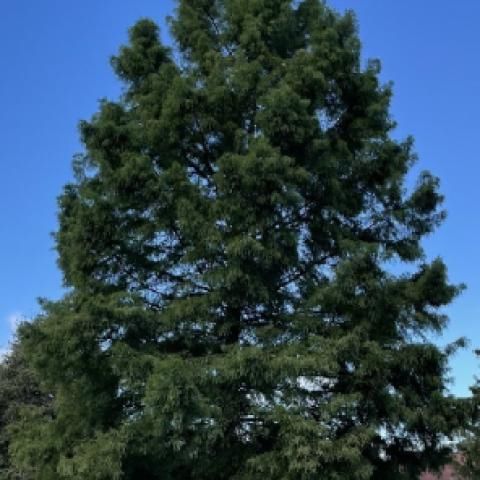
Bald Cypress
Taxodium Distichum
Although native to the southeast, this tree is hardy enough for northern Maine! The Bald Cypress, or Taxodium Distichum, grows in swamps and can thrive in year-round flooded areas, but it also survives in dry and compacted soils. Like the Dawn Redwood and Larches (it is in the same family as the Dawn Redwood), the Bald Cypress is a deciduous conifer, shedding its needles every autumn. The fall color is a pleasing orange, and the reddish to grayish brown bark contributes to winter interest. It grows 60 feet to 70 feet high and 25 feet to 30 feet wide.
Taxodium Distichum is a specimen tree with unique features, not the least of which are the protruding "knees" that grow around the tree in highly compacted or wet soils. These are areas, in fact, where few other tree varieties would thrive, much less grow additional features. The "knees" are very attractive, especially when combined with other landscaping features. Bald Cypress trees constitute an excellent choice for a deciduous conifer for parks or large lawns, especially those near bodies of water.
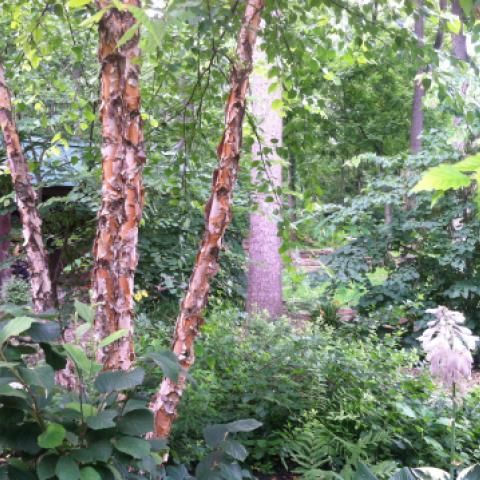
Birch (River) "City Slicker"
Betula Nigra "City Slicker"
The River Birch, or Betula Nigra, is a reliable, vigorous performer and one of the most adaptable and trouble-free members of the genus Birch. The River Birch "City Slicker" cultivar (Betula Nigra "City Slicker") has lighter bark and improved resistance to urban conditions.
River Birch is native to stream banks in the eastern deciduous forest. In the wild, it usually grows with multiple stems; however, single-stem specimens are less susceptible to breakage when mature. The cream-colored bark of the young tree ages to a pleasing scaly salmon color. Often planted without enough consideration for its rapid growth and potential large size, this tree usually reaches 50 feet in height with a 40-foot spread. The fall color is a respectable yellow. River Birch "Dura-Heat" is resistant to Bronze Birch Borers and Birch Leaf Miners, but it may become chlorotic in high pH soils.
One of our favorite companion plants for this tree is the Sweetbay, especially the "Moonglow" cultivar. The glossy, broad-leaf, semi-evergreen leaves of the Sweetbay enhance the year-round appeal of the River Birch bark. Consider plant shrubs with red and/or orange fall color beneath the River Birch to accent the bark and the fall shades. For a backdrop, use dark green conifers such as Oriental Spruce and Nordmann Fir.
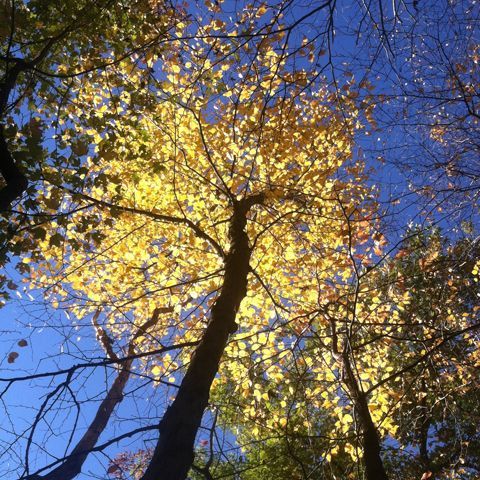
Birch (Sweet)
Betula Lenta
The Sweet Birch, or Betula Lenta, thrives high in the mountains often in dry, difficult conditions. Common in the wild, it is rarely offered in nurseries. People often focus on Birch trees with showy bark at the expense of the Sweet Birch. However, the rich summer foliage and golden fall color are reasons enough to invest in this fine tree. The Sweet Birch shows high resistance to Bronze Birch Borers and Birch Leaf Miners as well as tolerance for urban conditions and difficult growing sites. Also, the stems give off a pleasant wintergreen aroma when they are bruised as an interesting side note. Betula Lenta is also a long-lived tree with the oldest known specimen dated at 368 years old. It grows 40 feet or 50 feet high.
The Sweet Birch puts on an unrivaled fall show and should be planted where this can be fully enjoyed, such as among evergreens or other deciduous trees with orange and red fall color. A restful landscape scene often requires a mixture of both flamboyant and unassuming trees.
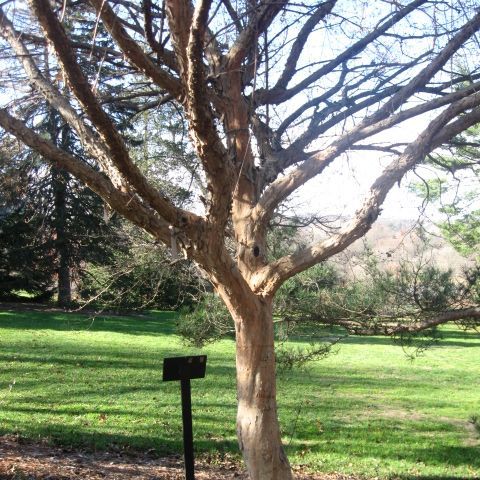
Dogwood (Japanese Cornel) "Lemon Zest"
Cornus Officionalis "Lemon Zest"
Check out the “Lemon Zest,” an improved cultivar of Japanese Cornel Dogwood or Cornus Officionalis! This selection was done by the Morris Arboretum in Philadelphia, and we are pleased to include it in our inventory.
The yellow flowers appear in late winter to early spring. They are larger than the species with a light lemon scent. Imagine beautiful spring evenings in your garden with this aroma on the breeze!
The young bark of the Japanese Cornel Dogwood “Lemon Zest” is a beautiful, exfoliating copper color that gradually changes to the typical, mottled ash-grey-and-orange of the mature stems of the species.
Japanese Cornel Dogwood “Lemon Zest” tolerates a wide variety of soils including clay and compacted soil. You should place this tree in a prominent location where the flowers will catch the eye and the lemon scent can be enjoyed even in late winter as a promise of the coming growing season! This tree also makes a beautiful complement to dark-colored evergreens in the spring.
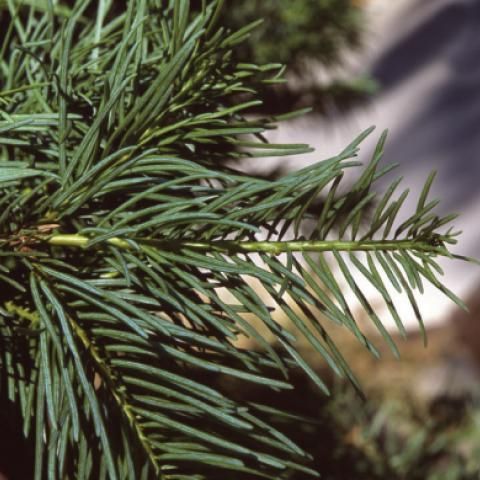
Fir (White)
Abies Concolor
Although native to the western United States, White Fir, or Abies Concolor, has also performed well in the east. The needles are 1.5 to 2.5 inches long, and the color varies from plant to plant. The color can range from light blue to medium green. The tree will reach 70 feet high and 25 feet wide. White Fir exhibits the distinctive Fir trait of the cones appearing upright on the branches, but an interesting note on the White Fir is that it might not produce cones or seeds for the first 40 years! White Fir is a hardy tree, tolerating dry and compacted soil. The habit is spire-shaped and narrow with tiered branches.
The popular Colorado Spruce (also known as Blue Spruce) has a similar outline and foliage color to the White Fir. Since we are seeing increased Cytospera infestations on the Colorado Spruce, we are recommending the White Fir as a superior substitute. Use as a specimen, in groupings, or for screening.
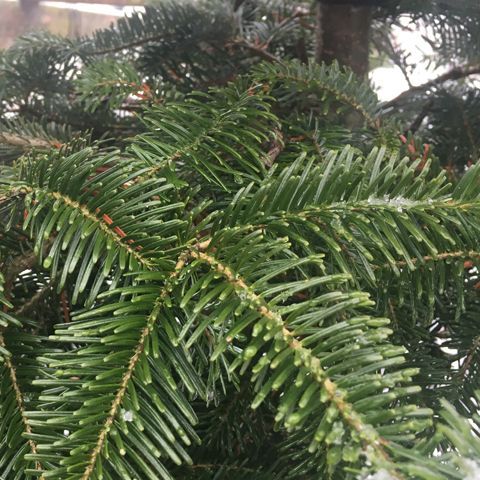
Fir (Turkish)
Abies X Bornmuelleriana
Turkish Fir, or Abies Bornmuelleriana, is a natural hybrid of Nordmann Fir and Greek Fir. It has a noble form and outline as so many Firs do. The upper side of the fragrant needles is a medium green, but the needles curve upward, exposing the silvery undersides for added beauty. The seed cones are purplish-brown and 4 to 6 inches long. Turkish Fir is a fast-growing tree, reaching a height of 50 to 80 feet with a spread of 10 to 15 feet.
A native of northwestern Asia Minor south of the Black Sea, Turkish Fir tolerates a wider range of temperature (meaning more summer heat) than most Firs. Also, this tree can handle less-than-ideal soil conditions, especially wetter soils. Mix Turkish Fir with deciduous trees to accent the fall color.
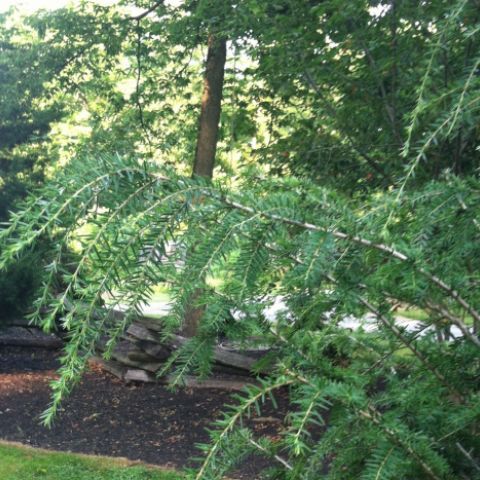
Hemlock (Chinese)
Tsuga Chinensis
Hemlocks are lovely trees, but the use of native species has been hindered by three debilitating pests: Hemlock Wooly Adelgid, Spruce Spider Mites, and Elongate Hemlock Scale. Chinese Hemlock, or Tsuga Chinensis, has shown resistance to all three pests, especially Hemlock Wooly Adelgid. Compared to Canadian Hemlock, the habit is more relaxed during the growing season and more rigid during the dormant season. The leaf color is a glossy, dark green. The growth rate is fast. Chinese Hemlock tolerates varying landscape conditions and grows well in either full sun or part shade. A native of the mountains of Southeast Asia, Chinese Hemlock has become a good, all-around, vigorous performer in North America.
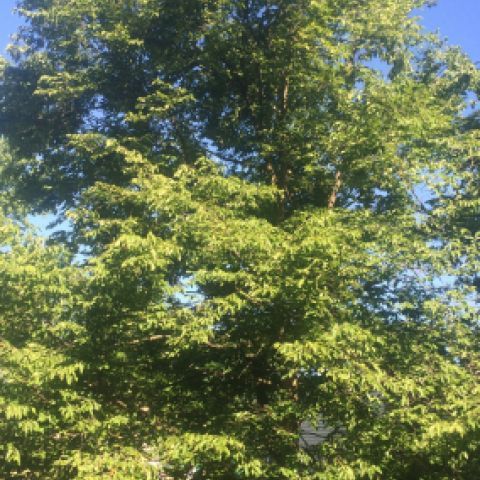
Hophornbeam (American)
Ostrya Virginiana
American Hophornbeam, or Ostrya Virginiana, is a small-sized to medium-sized native shade tree with flaking bark that blends perfectly with the medium-green foliage. The fall color is yellow. The bark and structure make a nice addition to the winter landscape.
Although a tough tree that will tolerate clay soil and drought well, American Hophornbeam may become tired and untidy-looking in late summer if growing conditions are difficult. This tree will blend nicely with most plants, and while not sensational in any season, it is always comfortably pleasing.
Hophornbeam grows to about 25 to 40 feet with a spread of 20 to 30 feet and can be used either as a specimen tree on the front lawn or as an accent plant at the corner of your house. It also makes a great understory tree in a naturalized situation. American Hophornbeam is also sometimes referred to as Ironwood due to its extremely hard, dense wood.
Hophornbeam is often used as a substitute for American Hornbeam, as Hophornbeam tolerates drought conditions better. Hophornbeam, however, does not tolerate wet soils. The habit of the Hophornbeam is more open than the American Hornbeam and is superior in summer. American Hornbeam's fall color, however, is more impressive.
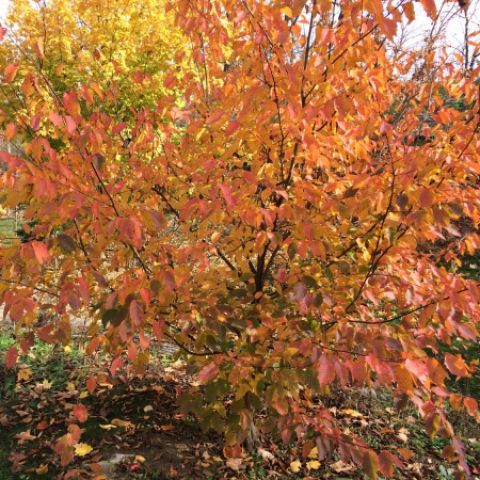
Hornbeam (American)
Carpinus Caroliniana
This tree has rich summer foliage with a dash of reddish new growth. Fall colors of yellow, orange, red, and burgundy. You’ll love the finely textured structure with a fluted trunk (which sometimes leads to its nickname of Musclewood) to add to the winter interest. All this describes the American Hornbeam, or Carpinus Caroliniana, a widespread understory tree growing 25 to 40 feet high. The American Hornbeam is native to the eastern United States deciduous forest. Small, dapper, and handsome, tolerating both full sun and part shade, this tree is also quite tolerant of compacted and clay soils. American Hornbeam also makes an excellent urban tree.
The American Hornbeam is a versatile tree that can be used as a specimen in the front lawn, as a corner accent plant, or as an understory tree in the backyard. American Hornbeam is resistant to Juglone and can be planted beneath Black Walnut. The leaves are marcescent, holding a warm tan into early winter.
The extremely hard wood of the American Hornbeam was once used by early Americans to make bowls, tool handles, and ox yokes. As the name suggests, the wood would take a horn-like polish.
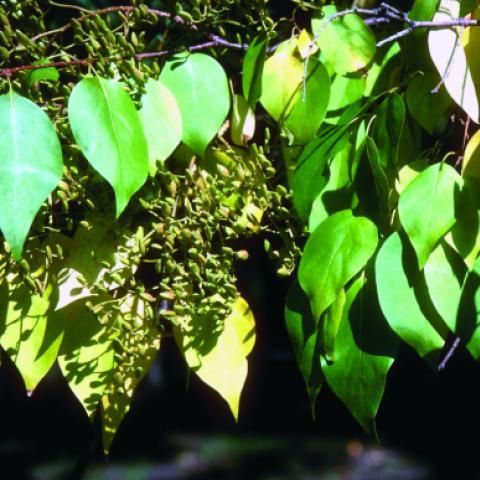
Lilac (Peking) "Beijing Gold"
Syringa Pekinensis "Beijing Gold"
The “Beijing Gold” Lilac, or Syringa Pekinensis, is a tree Lilac with good form and excellent late-spring flowers. Although the bark is not as showy as the "China Snow," the outline is superior with a straighter stem and more balanced growth habit. The fall color is a beautiful yellow with a touch of orange. Tolerant of difficult growing conditions, this tree Lilac grows up to 20 feet high and 15 feet wide with a slightly smaller spread. Although native to wooded areas on slopes, valleys, and ravines in northern China, Peking Lilac trees do very well in North America.
You can use it as a street tree, a specimen plant, or a corner accent. Peking "Beijing Gold" Lilac is a very versatile tree.
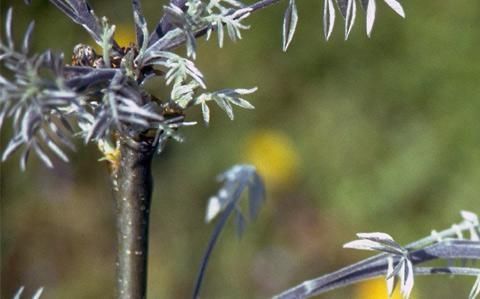
Maacki (Amur)
Maacki Amurense
Amur Maacki, or Maacki Amurense, is a handsome tree, though little known and used. The foliage emerges a unique, blue-green color and matures to a rich, dark green. The leaves are each composed of five to seven leaflets that are 1.5 to 3.5 inches long. The spike-like clusters of white flowers blossom during midsummer when few other trees are blooming. Even the scaly bark is quite handsome, peeling into curls and flakes as the tree ages. The fall color is yellow-green. A tough tree, Amur Maaki takes compacted and dry soils in stride. Infertile soils are not a problem either, as this tree fixes atmospheric nitrogen. It matures at about 25 to 40 feet high and 20 to 30 feet wide.
Amur Maacki can be used as a small shade tree, a patio tree, a street tree, or for other specimen use. We would avoid placing it in groupings. Although an ornamental tree when used alone, blending it with other trees of the same size will result in its being lost in the crowd.
The Amur Maacki tree honors both its discoverer and its original habitat. Karlovich Maack, a 19th-century Siberian explorer, discovered this tree growing in the region of the Amur River, the border between China and Siberia. It was introduced into cultivation in 1864.
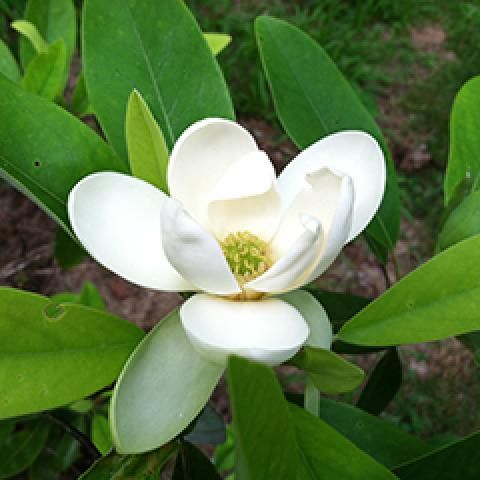
Magnolia (Sweetbay) "Moonglow"
Magnolia Virginiana "Moonglow"
The lemon scent of the Sweetbay, or Magnolia Virginiana, blossoms on an early summer evening is like nothing else. The 2-inch to 3-inch, cream-colored flowers, while very attractive individually, would be visually overwhelming if they appeared in too large of numbers. Fortunately, they don't grow this way. Instead, the blooms appear a few at a time over a period of four to six weeks, giving us a lovely aroma that begins about the first of June and lasts well into July. As summer breezes stir the leaves, they expose the silvery undersides, adding to the soft, ornamental beauty of the plant. The red fruit appears in late summer. Sweetbay is very attractive even in winter!
Sweetbays are native to marshy areas of Appalachia and tolerate wet feet better than most Magnolias. Pest-resistant and disease-resistant, they are available in clump or single-stem plants and grow 10 to 35 feet tall. The leaves are deciduous in northern parts of the country but evergreen in the deep South.
Sweetbay can be used as a specimen, a corner accent, or an understory plant, but possibly the best use is to place it in the foreground of brick or stone masonry. Sweetbay also makes an almost perfect contrast plant for both broadleaf deciduous trees and evergreen conifers.
The genus name, Magnolia, honors Pierre Magnol, a French botanist who lived from 1638 to 1715, while the species - Virginiana - means “of Virginia.”

Maple (Paperbark)
Acer Griseum
The Paperbark Maple, or Acer Griseum, has many positive traits. The attractive foliage is a medium-green to blue-green, and the burgundy-red, exfoliating bark provides a level of winter interest that is almost unmatched. Tolerant of poor soils and urban conditions, it grows slowly to reach approximately 30 feet in height. Paperbark Maple has no significant disease or insect problems. Since it is not readily available commercially, it is, however, seldom planted. This is a loss to all of us.
E. H. Wilson imported this tree into England from China in 1899. The Arnold Arboretum introduced it into the United States shortly thereafter.
Acer Griseum is hardier and more amenable to those tough urban conditions than the commonly used Japanese Maples. You can also use it as a specimen, a corner accent, in groupings, or in front of a light-colored hardscape such as a stone wall. The Paperbark Maple's bark is especially eye-catching after a fresh snowfall, so situate it where it can be appreciated in the winter landscape.
At Woodlawn LLC, we have an excellent selection of Paperback Maple. Stop by to get yours today!
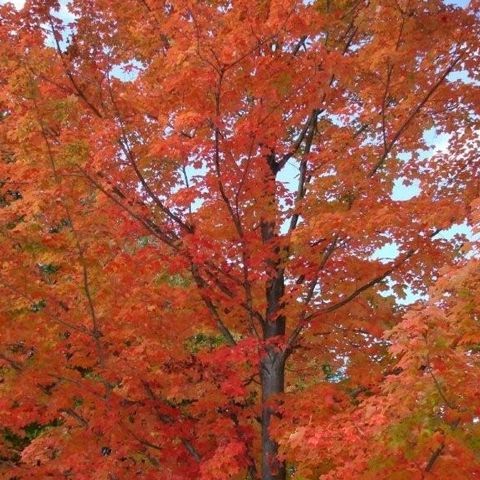
Maple (Red) "Sun Valley"
Acer Rubrum "Sun Valley"
Although the Red Maple trees, or Acer Rubrum, have red spring flowers, wonderful shade, and exceptional fall color, they are, as a species, an ornamental inferiority to the flaming Sugar Maple. The Red Maple does hold one trump card over the Sugar Maple, however. It tolerates urban conditions much better. Is there any way to have the best of both of these worlds? There is! The Red Maple cultivar “Sun Valley” has been selected for superior ornamental traits almost matching those of the Sugar Maple, while retaining the amenability to urban culture of the Red Maple. “Sun Valley” maple is a very desirable tree.
With its smaller leaves and lovely orange-red fall color, the spring flowers and fall color of “Sun Valley” are enhanced by blending it with evergreens. Pruning to develop structure is very important as this tree is prone to developing co-dominant stems. “Sun Valley” Maple grows 50 to 60 feet high and 30 to 40 feet wide and is tolerant of both wet and dry soils.
Please accept one word of caution. Red Maple trees are widely planted, sometimes to the point of creating monocultures. Choose another tree if you or your neighbors have 10% or more of this species. Since they are native to eastern North America from Quebec to Minnesota and south to Florida and eastern Texas, they are ubiquitous throughout much of North America.
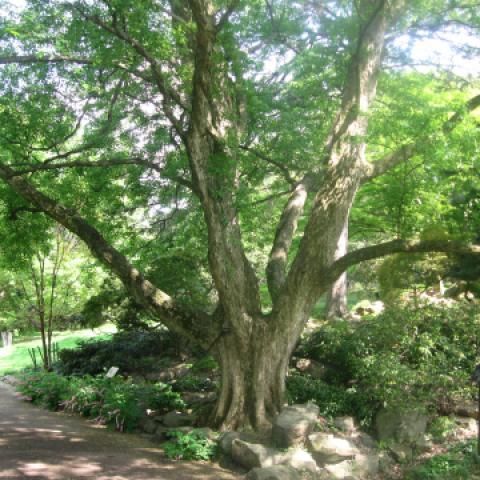
Maple (Trident)
Acer Buergerianum
Native to China, Korea, and Japan, Trident Maple, or Acer Buergerianum, is a handsome, small-sized to medium-sized Maple reaching 20 to 30 feet tall with an equal spread. It exhibits glossy, dark-green foliage and pleasant shade with an attractive, oval-to-round branching structure and exfoliating bark. On old trunks, this gray, orange, and brown exfoliation is especially attractive.
A versatile tree, Trident Maple is tolerant of difficult growing sites and urban situations and, unlike many Maples, is resistant to leaf scorch even under drought stress. It makes an excellent choice for small residential lots and sites beneath utility wires. The fall color is red and orange with good leaf fall.
The name Trident comes from its three-lobed (or tri-lobed) leaves.
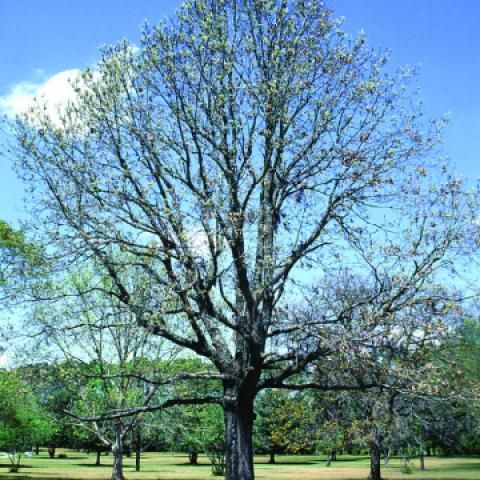
Oak (Black)
Quercus Velutina
A common tree in the Appalachian forests, Black Oak, or Quercus Velutina, is rarely found in nurseries and, unfortunately, is seldom planted. With its rich, glossy foliage, it is possibly the best shade tree in the Red Oak group. The bold, dark structure of the tree in the dormant season makes it a valuable addition to the winter landscape, especially after a snowfall. The bark is also interesting, featuring black with a blocky pattern. Its acorns are a food source for many birds and other wildlife. In fact, although it is a wonderful yard and park tree, its prolific acorn production sometimes precludes its use as a street tree due to the extensive cleanup required.
Black Oak is more tolerant than Red Oak to urban growing conditions and is also resistant to Oak Wilt and Bacterial Leaf Scorch. It will tolerate a variety of poor soils in the wild with dry, sandy, and heavy clay among them. It grows 60 to 80 feet high and 30 to 40 feet wide. Black Oak is primarily native to slopes, ridges, and upland hills from Florida to Texas. It can also be found north to Maine and west to Michigan and Minnesota.
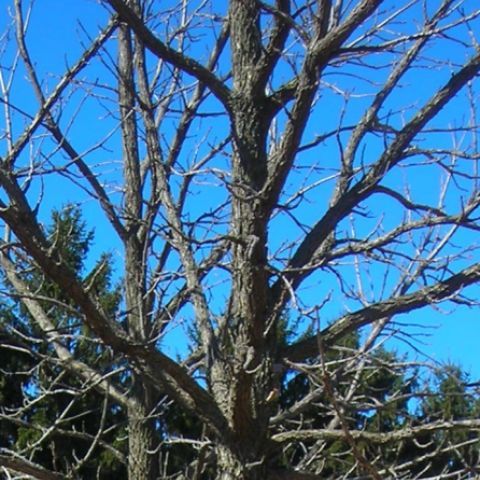
Oak (Burr)
Quercus Macrocarpa
Burr Oak, or Quercus Macrocarpa, one of the most majestic of our native oaks, is an adaptable tree with a rugged, cork-like bark texture that is especially noticeable when the tree is young. Summer foliage is a rich green, and fall color is a warm brown. The leaves are especially large. They can be 10 to 12 inches long! The winter outline is bold and open.
Burr Oak is a superb specimen tree, very tough and tolerant of both acidic and alkaline soils. It also handles either poorly drained or dry soils with relative ease and makes a fine urban tree if given enough space. Speaking of space, give it plenty. Quercus Macrocarpa can grow for centuries, reaching a height of 60 to 80 feet with a spread of equal size. This is one of those legacy trees. We plant them with the knowledge that our children and grandchildren will receive more benefits from them than we will.
That's perfectly okay. Tree planting is all about giving, not getting!
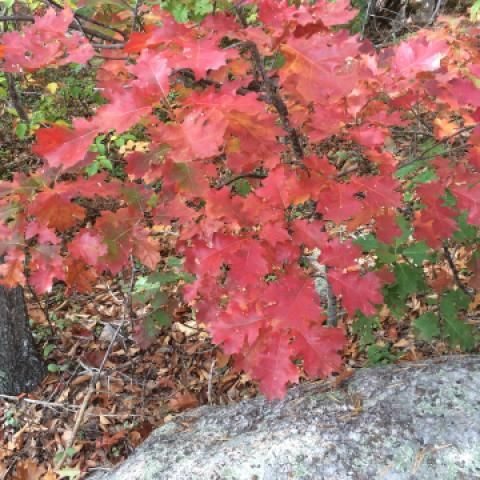
Oak (Scarlet)
Quercus Coccinea
High in the mountains on dry, rocky ridges in obviously inhospitable growing conditions, the Scarlet Oak, or Quercus Coccinea, flourishes. Because of its lower lumber value, foresters consider it a second-rate species. In the landscape, however, it is one of our best Oaks as it thrives in difficult soils and challenging urban and suburban environments. Often misidentified as Pin Oak, Quercus Coccinea is much more tolerant of alkaline soils.
The foliage of the Scarlet Oak is a rich, dark, almost reflective green during the growing season and an outstanding scarlet red in the fall. This flaming autumn beauty often lasts three to four weeks. Similar in size to the other large native Oaks, Scarlet Oak matures in the landscape at about 70 feet high and 30 to 40 feet wide.
If Quercus Alba is the standard by which we measure all trees in the White Oak group, Quercus Coccinea ought to be the standard by which all trees in the Black Oak group are measured. Several close contenders do exist, but the brilliance of Scarlet Oak's fall color puts it ahead of the rest. Plant it as a specimen shade tree and enjoy its glory for years to come!

Oak (Shumard)
Quercus Shumardi
The Shumard Oak, or Quercus Shumardi, is an endangered species in the forests of Pennsylvania as only a few groves exist in Adams and Fulton counties. As an urban or suburban tree, Quercus Shumardi is much superior to the similar Pin Oak, as it tolerates high pH soils and adverse conditions much better. The Shumard Oak's fall color is also more reliable than the Pin Oak with orange, red, and burgundy appearing around the end of October. Size is comparable to most other large Oaks, reaching close to 70 feet with a slightly smaller spread. Pyramidal in youth, the canopy spreads to a broader, more open crown with age.
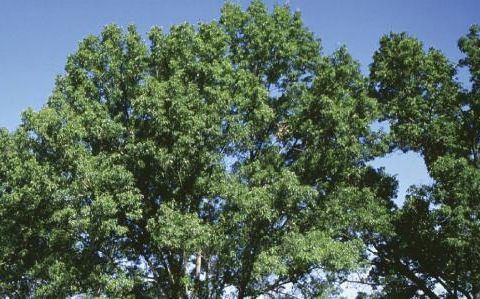
Oak (Swamp White)
Quercus Bicolor
If you want a bold, durable, and magnificent tree. Consider Swamp White Oak or Quercus Bicolor. This tree grows 50 to 60 feet tall with a spread of the same size, and it is a very similar tree to White Oak. They share the same aura of nobility with wide, spreading canopies of similar dimensions. Both are in the White Oak group.
There are a few differences. Swamp Oak bark is broken into smaller plates. Moreover, Swamp Oak tolerates compacted and wet soils better than White Oak, and it is easier to transplant than White Oak. Swamp Oak leaves are a darker green during the growing season. The leaves of the Swamp White Oak are shiny green on the top and silvery white on the bottom. That is the reason for the species name, Bicolor. Overall, Swamp Oak's fall color is inferior to White Oak's, but Swamp White Oak acorns are more likely to attract wildlife than White Oak's are.
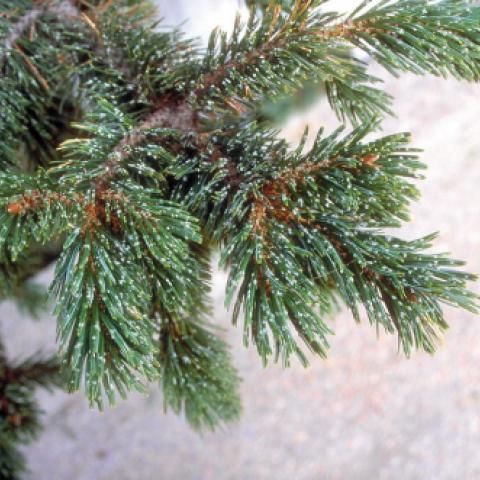
Pine (Bristlecone)
Pinus Aristata
Bristlecone Pine, or Pinus Aristata, is a native of the western United States. Extremely slow-growing, this dwarf, shrubby tree makes an excellent choice either for rock gardens or as a foundation plant. It grows 8 to 20 feet tall. Bristlecone Pine is a reliable, trouble-free specimen plant. The long, blue-green needles grow in bunches of five and tend to be very resinous.
Bristlecone Pines are one of the oldest trees on the planet with specimens ranging from 4,000 to 5,000 years old. They can thrive in very dry, rocky, and inhospitable conditions and tolerate a wide range of soil pH levels.
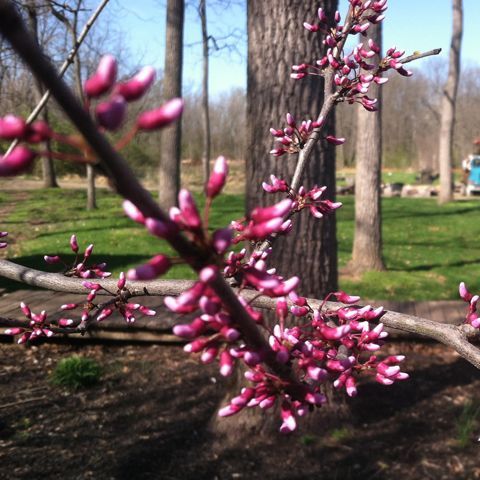
Redbud
Cercis
With a Redbud, the foliage is attractive during the growing season, the yellow fall color can be quite nice, and the reddish bark adds to the ornamental appeal during the dormant season. However, without question, spring is the high point for the Eastern Redbud. Brilliant, purple-pink flowers in profusion create a party atmosphere that begins in early to mid-April and persists for as long as four weeks.
The name Redbud is a misnomer. Neither the buds nor the flowers are red.
In the last 10 years, the cultivars have multiplied. Weeping forms and cultivars with foliage sporting shades of purple, yellow, orange, and variegated white have taken the market by storm. They can't even leave the flowers alone. There's a cultivar with white flowers. (What do you call that? A Whitebud?) While some of these forms are exciting and eye-catching in the formal landscape, the species is a great tree that may blend more naturally in the garden.
At Woodlawn LLC, we also grow “Avondale,” which is a cultivar of the Chinese Redbud. Chinese Redbud is even more gaudy than our native Redbud with rich pink flowers in profusion, covering not only the ends of the branches but also the stems.
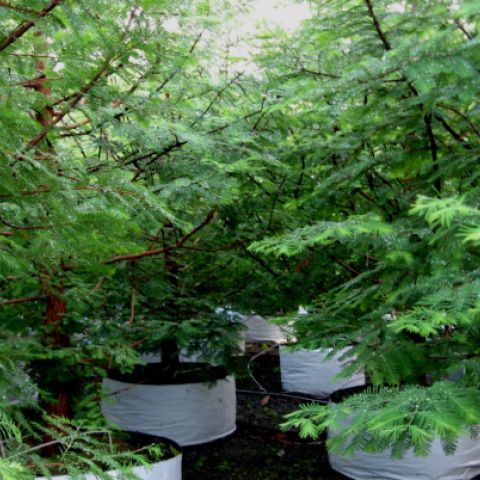
Redwood (Dawn)
Metasequoia Glyptostroboides
Redwood Dawn is about gentle grandeur. With soft foliage, this tree has a fluted trunk and lovely bark with a burnt-orange color in the fall. It’s a great choice for durability since it is resistant to insects and diseases. It’s also hard to damage even in tough storms. All around, this is an excellent tree when planted in the proper location. It’s a fast-growing choice for your property!
Distantly related to the majestic Redwoods of the West Coast, Dawn Redwoods, or Metasequoia Glyptostroboides, will furnish the same aura of grandeur for anyone walking among their feathery, pyramidal forms. Unlike the coastal Redwoods which are limited to high-pressure and moist atmospheric conditions, Dawn Redwoods thrive in eastern North America.
Native to western China and not discovered until 1941, Dawn Redwoods tolerate moist to wet soils and become 70 to 100 feet tall with a spread of 15 to 20 feet. Plant it as a specimen or, better still, in groupings to create your own California forest. The soft, green foliage will blend almost anywhere.
Do allow plenty of room for your Dawn Redwood to reach for the sky. 2 to 3 feet of vertical growth per year under ideal conditions is common.
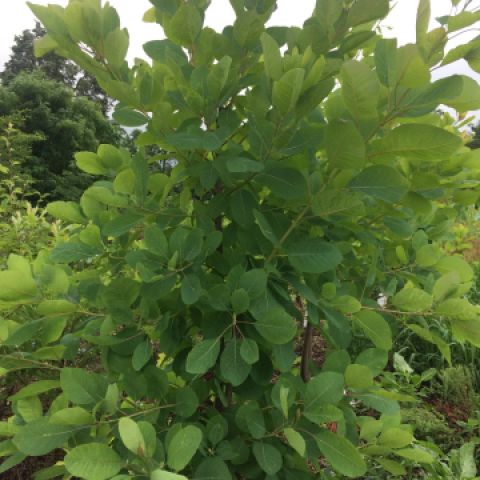
Smoketree (American)
Cotinus Obovatus
American Smoketree, or Cotinus Obovatus, is an ornamental plant in its own right. A tough tree, it grows naturally in rocky outcroppings in the lower Midwest. The flowers are insignificant, but the billowy hairs attached to the elongated stalks of the spent flower clusters turn a smoky, purplish-pink in midsummer, giving the tree a most unusual and attractive appearance. This floral effect is on show for weeks. The soft-green foliage turns a pleasing mid-green in late summer. The American Smoketree exhibits excellent fall color. Actually, it produces some of the best fall colors of our native trees and shrubs with corky bark. It shows a toleration for high pH soils and difficult growing conditions. So why isn't this tree used more? Most plantsman are indifferent and the public is naïve. This tough little performer is one of those horticultural secrets. Plant one and enjoy. It grows 20 to 30 feet tall with an equal-sized spread.
Many gardeners are familiar with the inferior European Smokebushes with their purple and blue leaves, but the gentle, lime-colored foliage of the American Smoketree is easily superior. Show off the foliage by planting it among and in front of plants with darker-colored foliage. Flowering on the Smoketree occurs in mid-summer or late-summer. Use it to liven up the tired, season-worn landscape. American Smoketree has a medium texture that allows it to blend with a wide variety of other plants.
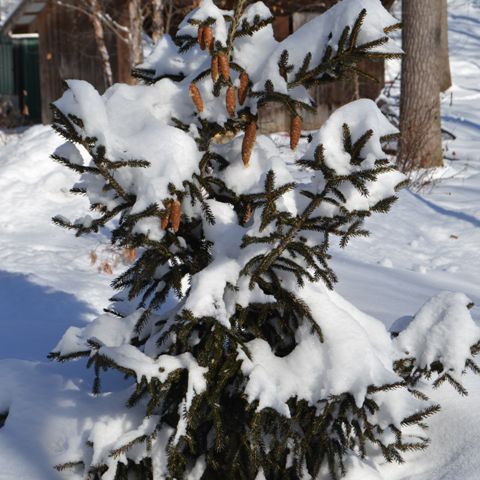
Spruce (Oriental) "Gowdy"
Picea Orientalis "Gowdy"
Selected from the graceful Oriental Spruce, “Gowdy” is, unsurprisingly, a first-rate ornamental. Three characteristics separate the “Gowdy” Oriental Spruce, or Picea Orientalis “Gowdy,” from the rest of the species: smaller size, informal growth, and slate-grey stems. The literature puts the mature height at 8 feet to 10 feet, but we suspect that it will usually exceed that. The foliage emerges a soft, light green and matures to a rich, dark green. This tree, like the species as a whole, tolerates shade better than most Spruces. Very pleasing in snowy winter, “Gowdy” is a lovely specimen plant for small spaces.
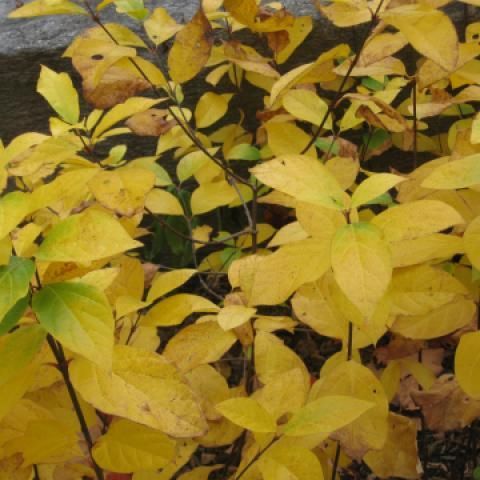
Sweetshrub
Calycanthus Floridus
Sweetshrub is unassuming, comfortable, and attractive. Somehow Sweetshrub, or Calycanthus Floridus, fits anywhere. Put it next to the stone wall, along the border to the patio, or as a foundation plant. In the scurry to place gaudy sensations in the landscape, homeowners and landscapers have overlooked the Sweetshrub's calm, solid performance. In the past, the leaves and flowers of this plant were used to provide a freshener for the insides of clothes drawers and women's purses. The foliage also makes a fine addition to potpourri. The cultivar “Michael Lindsey” has glossier foliage and more fragrant flowers. The fall color is a beautiful yellow. Sweetshrub tolerates occasionally wet soil yet withstands drought moderately well. It can supposedly grow to 8 to 10 feet, but in our garden, Sweetshrub only reached 3 or 4 feet high with a spread of 6 to 8 feet. A native of the southeastern seaboard from Virginia to Florida, Sweetshrub is also commonly known as Carolina Allspice, in reference, of course, to its fragrant scent.
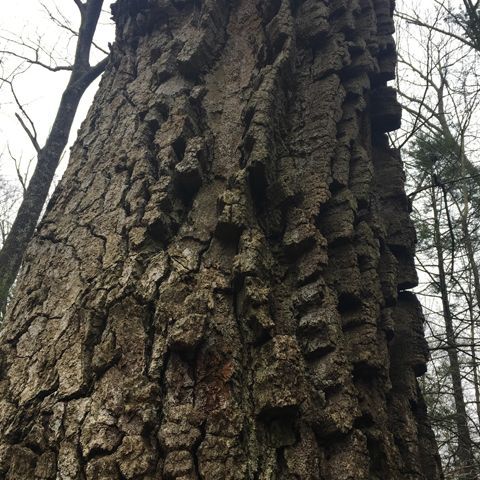
Tupelo
Nyssa Sylvatica
They're tough and durable. They can thrive in poorly drained soils as well as dry uplands. Soil compaction? Not a problem. Black Tupelo is not only a dogged performer but also a beautiful addition to almost any landscape. The most outstanding feature is the foliage: glossy, dark green in the summer changing to a stunning array of orange and red hues in the fall. Another attractive feature is the horizontal branching which, with a little creative placement, can make an appealing statement in the dormant season.
The longevity of Black Tupelos is remarkable. There are living specimens that are hundreds of years old.
Overall, Black Tupelo is a great tree in its own right, but cultivars have been gradually developed in the last 20 years, producing even more trees that lend the perfect touch. Even so, if you're looking for a natural and informal addition to your garden, the species is still best. The cultivars work best in formal landscapes such as specimens and when planted along walkways.
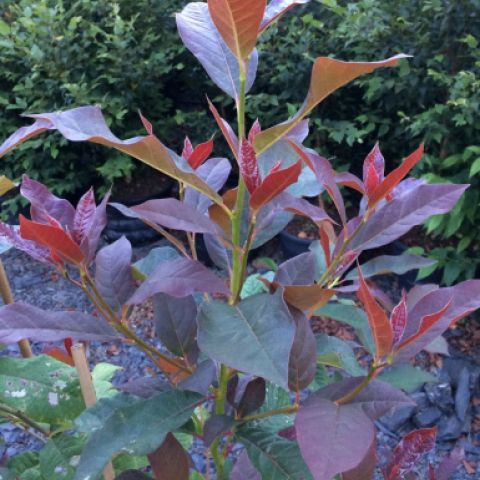
Tupelo (Black) "Wildfire"
Nyssa Sylvatica "Wildfire"
Black Tupelo is a beautiful native landscape tree known for its exceptional fall color. The cultivar Black Tupelo “Wildfire” offers an exciting addition with its reddish new growth adding splashing color to the summer landscape. Foliage matures to a rich, glossy green, resistant to fungal diseases. During the dormant season, the horizontal branches produce a layered outline. Hardy and resilient, Black Tupelo “Wildfire,” or Nyssa Sylvatica “Wildfire,” tolerates urban soil environments quite well provided the pH is not too high. The growth rate is slow to medium. Black Tupelo grows 40 to 50 feet high and 20 to 30 feet wide.
To showcase Wildfire’s new growth, avoid planting the tree among or in front of dark-colored objects or trees. American Smoketree, with its lime-green foliage, makes a wonderful companion plant. With its strong, horizontal branching, Black Tupelo's structure will serve as a visual anchor in the garden. The structure makes an excellent silhouette in the dormant season so, if possible, plant where the outline is visible above the horizon. This also allows the blue sky to serve as a perfect background for the brilliant fall color.
"And out of the ground made the Lord God to grow every tree that is pleasant to the sight..."
You will get good quality trees.
- Troy W. via Google
Learn More About Woodlawn LLC
Located at 3171 Ritner Hwy, Newville, PA. Woodlawn LLC specializes in trees, tough trees, native trees, and tree care services. Certified arborist. 30+ years of experience. Competitive prices. Call now.
serving Area
Newville, PA
New Paragraph


Share On: